| Back to . .
.
Deposit #66 |
 A Simulation of Pursuit Curves |
 |
|
For best performance of the animation, please use Google Chrome or FireFox. First, to begin the animation look below. Change the speed settings for Achilles and the Tortoise by using the sliders. Secondly, click anywhere in the window to represent Achilles' starting position and then click elsewhere to represent the Tortoise's starting position. Once there are two circles on the screen press the Start button. Tortoise x Speed : Tortoise y Speed : Achilles Speed : |
|
|
Achilles
and the Tortoise |
|
Historical Sketch:
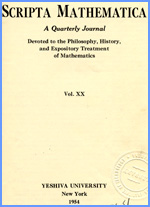 An excellent overview of the history of pursuit curves is
found in a series of articles written by Arthur Bernhart (University of
Oklahoma) and published in Scripta
Mathematica in the 1950s. He organizes his review into
four categories: pursuit curves where the pursued moves along a
straight line; the chase takes place in a circular fashion; the race
among several competitors is in a polygonal fashion; and finally,
special cases involving dynamical pursuit with variable speeds, centers
of gravity, and other aberrant properties. This series of
articles
cuts across centuries of time, countries and languages.
An excellent overview of the history of pursuit curves is
found in a series of articles written by Arthur Bernhart (University of
Oklahoma) and published in Scripta
Mathematica in the 1950s. He organizes his review into
four categories: pursuit curves where the pursued moves along a
straight line; the chase takes place in a circular fashion; the race
among several competitors is in a polygonal fashion; and finally,
special cases involving dynamical pursuit with variable speeds, centers
of gravity, and other aberrant properties. This series of
articles
cuts across centuries of time, countries and languages.A bit of historical background is fascinating. The publications by Bernhart and several others often begin in antiquity with Zeno's solution to the classic Achilles and the Tortoise, mention the work of Leonardo da Vinci, and then move to a Frenchman, Pierre Bouguer (1698-1758) who expanded pursuit to two dimensions. Interest crossed the border into Italy, where the problem became curva di caccia, and then into Germany where readers will find dachshunds in Hundekurven problems. Across the English Channel a spider was pursuing a fly in the well-known Ladies' Diary (1743,1750 and 1752).
I.
Category One: One
dimensional pursuit in a plane with a linear
track and uniform speeds.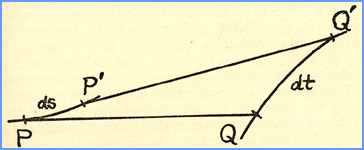 Let the point Q move along a given tract Q(t) while another point P moves always in the direction PQ on P(s). If the velocity vector dP/ds has the same sense as PQ, the locus P(t) is called a curve of pursuit, otherwise a curve of flight. |
||||||
II.
Category Two:
Pursuit curves for a circular track.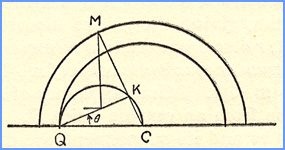 "A
dog at the center of a
circular pond C makes
straight for a duck which is swimming along the edge of the pond.
If the rate of swimming of the dog is to the rate of swimming of the
duck as m : 1, determine the
equation of the curve of pursuit and the distance the dog swims to
capture the duck." "A
dog at the center of a
circular pond C makes
straight for a duck which is swimming along the edge of the pond.
If the rate of swimming of the dog is to the rate of swimming of the
duck as m : 1, determine the
equation of the curve of pursuit and the distance the dog swims to
capture the duck."C is the center of the pond, Q is the "quacker," and the point of attack is K, which conveniently forms an inscribed right triangle. American Mathematical Monthly, 27 (1920), p.
31
A. S. Hathaway, Houston, Texas |
||||||
III.
Category Three:
Problems of triangular pursuit.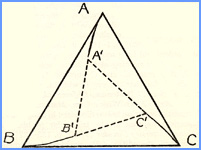 "Three dogs are placed at the three vertices of an equilateral triangle; they run one after the other. What is the curve described by each of them? |
||||||
| IV.
Category Four:
Differential equations valid for
arbitrary track and variable speeds; Miscellaneous problems sometimes confused with pure pursuit curves.  "Navigation:
Does one swimmer P
pursue another Q
when his course is
toward Q though
his heading is somewhat
upstream? If P
swims through the water medium at speed e, and the current flows with
speed f at an
angle φ with the desired course PQ, then P must head off course by a
correction angle ε in order to make good his course. "Navigation:
Does one swimmer P
pursue another Q
when his course is
toward Q though
his heading is somewhat
upstream? If P
swims through the water medium at speed e, and the current flows with
speed f at an
angle φ with the desired course PQ, then P must head off course by a
correction angle ε in order to make good his course.
The opportunities for animation of pursuit curves are enormous. The NCB invites faculty and students to try their hand at some of these problems as class projects. Then hopefully you will add a "choice" effort to our NCB MATH Archive collection as a sampler of a fun activity from your campus. |
||||||
|
|
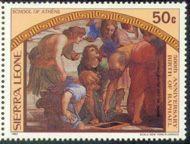 Click on the stamp to see Zeno in Raphael's "School of Athens" near the Sistine Chapel in the Vatican. |
|||
|
For more information on Pursuit Curves: < http://en.wikipedia.org/wiki/Curve_of_pursuit > |
||||
| For a variety of Pursuit Problems: < http://mathworld.wolfram.com/topics/ApolloniusPursuitProblem.html > | ||||
| For the evolute in
JAVA: < http://www-history.mcs.st-and.ac.uk/history/Curves/Pursuit.html
> Note: The French scientist Pierre Bouguer attempted to measure the density of the Earth by using a plumb line deflected by the attraction of gravity. He collected data on the top of a Peruvian mountain. While he was more or less unsuccessful, the thought that he would attempt this in South America in 1740 is slightly amazing. |
||||
| Gray, Alfred, Modern Differential Geometry of
Curves and Surfaces with MATHEMATICA®,
2nd ed., CRC Press, 1998, pp. 66-69. |
||||
| Weisstein, Eric W., CRC
Concise Encyclopedia of MATHEMATICS, CRC Press, 1999, p.1461. |
||||
| Yates, Robert C., Curves and Their Properties, NCTM, 1952, pp. 170-171. | ||||
|
||||


